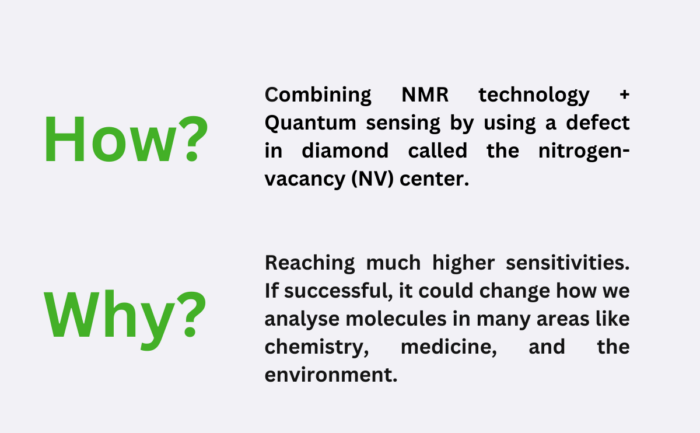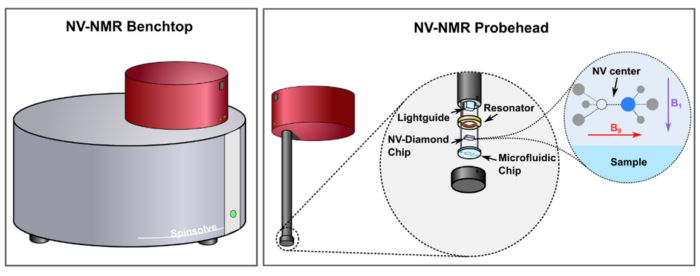Quench, is Horizon Research and Innovation Actions (RIA) project that started in January 2024, consists of 7 partners from 4 different countries aiming to upgrade small Nuclear Magnetic Resonance (NMR) machines (called NMR spectrometers).

We are aiming to revolutionize benchtop NMR spectrometers by integrating quantum sensing techniques, specifically leveraging nitrogen-vacancy (NV) centers in diamond, to greatly enhance sensitivity, enabling breakthroughs in molecular analysis across various fields such as analytical chemistry, quality control, medical diagnostics, and materials discovery.
What is Nuclear magnetic resonance (NMR) spectroscopy?
Nuclear magnetic resonance (NMR) spectroscopy is a molecular fingerprinting technique that helps scientists to figure out the structure and behaviour of molecules by looking at how their atoms interact with magnetic fields. “ It is the workhorse of modern molecular structural analysis with countless scientific applications, from materials science to drug discovery”
What is nitrogen-vacancy (NV) center
The nitrogen-vacancy (NV) center is a point defect found in diamonds where a nitrogen atom replaces a carbon atom adjacent to a vacancy (missing carbon atom) in the diamond lattice structure. It has unique quantum properties, making it sensitive to magnetic fields and allowing it to be used as a sensor for various applications, including quantum computing, sensing, and imaging.
Objectives
This project aims to develop a quantum-enhanced NV-NMR probe for high-resolution benchtop NMR spectroscopy, easily interfacing with Magritek benchtop NMR instruments operating at a magnetic field of 1 T. Compared to traditional inductive detection, the NV sensor will achieve 100 times better concentration sensitivity and require only 1% of the sample volume, without sacrificing NMR spectral resolution.

An interdisciplinary approach is necessary to develop the quantum-enhanced benchtop NMR spectrometer. This project incorporates a range of scientific, technological, and industrial disciplines, all necessary for successfully completing its challenging tasks. For example, the diamond sensor requires state-of-the-art material engineering capabilities, such as chemical vapor deposition growth techniques, with high control over the implemented gas materials and their isotopic content. The raw crystal needs to be further processed by a range of polishing, cutting, and annealing tools, to bring it to its required shape and size. In terms of the detection probe head, its development involves a range of fields, such as microwave and RF engineering, mechanical design and complex optics integration. Our leading industrial partner of compact benchtop NMR spectrometer developed the permanent magnet which we will be using in this project after many years of optimizing magnet design and construction for homogeneity and temperature stability. The core technique at the focus of this project is magnetic resonance, where we use both NMR and optically detected spin resonance. In these fields, we will incorporate advanced pulse techniques relying on a deep understanding of the spin physics and quantum behaviour of the electron and nuclear spins in the diamond detector and the nuclear spins in the sample of interest. Most importantly, the project requires a profound synergy between different research areas, such as quantum physics, spectroscopy, electrical engineering, material engineering, and magnetic resonance, all necessary for its successful completion. Finally, QUENCH brings together academic institutes, an applied research institute, and a leading NMR company, and bridges the gap between theoretical knowledge and practical applications, ultimately leading to more impactful and innovative solutions.
